Found Tick on Dog What to Do

BLACKLEGGED TICK Ixodes scapularis
WHERE FOUND Widely distributed across the eastern United States.
TRANSMITS Borrelia burgdorferi and B. mayonii (which cause Lyme disease), Anaplasma phagocytophilum (anaplasmosis), B. miyamotoi disease (a form of relapsing fever), Ehrlichia muris eauclairensis (ehrlichiosis), Babesia microti (babesiosis), and Powassan virus (Powassan virus disease).
COMMENTS The greatest risk of being bitten exists in the spring, summer, and fall in the Northeast, Upper Midwest and mid-Atlantic. However, adult ticks may be out searching for a host any time winter temperatures are above freezing. All life stages bite humans, but nymphs and adult females are most commonly found on people.
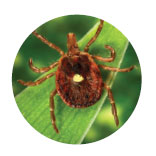
LONE STAR TICK Amblyomma americanum
WHERE FOUND Widely distributed in the eastern United States, but more common in the South.
TRANSMITS Ehrlichia chaffeensis and E. ewingii (which cause human ehrlichiosis), Francisella tularensis (tularemia), Heartland virus (Heartland virus disease), Bourbon virus (Bourbon virus disease), and Southern tick-associated rash illness (STARI).
COMMENTS The greatest risk of being bitten exists in early spring through late fall. A very aggressive tick that bites humans. The adult female is distinguished by a white dot or "lone star" on her back. The nymph and adult females most frequently bite humans.
Allergic reactions associated with consumption of red (mammalian) meat have been reported among persons bitten by lone star ticks.
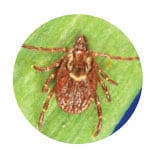
AMERICAN DOG TICK Dermacentor variabilis
WHERE FOUND Widely distributed east of the Rocky Mountains. Also occurs in limited areas on the Pacific Coast.
TRANSMITS Francisella tularensis (tularemia) and Rickettsia rickettsii (Rocky Mountain spotted fever).
COMMENTS The greatest risk of being bitten occurs during spring and summer. Adult females are most likely to bite humans.
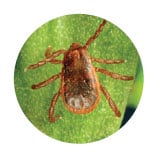
BROWN DOG TICK Rhipicephalus sanguineus
WHERE FOUND Worldwide.
TRANSMITS Rickettsia rickettsii (Rocky Mountain spotted fever). Primary vector for R. rickettsii transmission in the southwestern United States and along the U.S.-Mexico border.
COMMENTS Dogs are the primary host for the brown dog tick in each of its life stages, but the tick may also bite humans or other mammals.
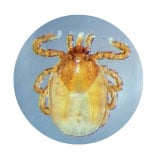
GROUNDHOG TICK Ixodes cookei
WHERE FOUND Throughout the eastern half of the United States.
TRANSMITS Powassan virus (Powassan virus disease).
COMMENTS Also called woodchuck ticks. All life stages feed on a variety of warm-blooded animals, including groundhogs, skunks, squirrels, raccoons, foxes, weasels, and occasionally people and domestic animals. Photo courtesy of Steve Jacobs, PSU Entomology
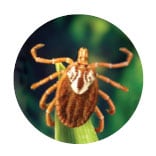
GULF COAST TICK Amblyomma maculatum
WHERE FOUND Southeastern and mid-Atlantic states and southern Arizona.
TRANSMITS R. parkeri (R. parkeri rickettsiosis), a form of spotted fever.
COMMENTS Larvae and nymphs feed on birds and small rodents, while adult ticks feed on deer and other wildlife. Adult ticks have been associated with transmission of R. parkeri to humans.
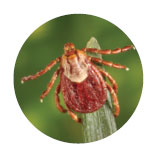
ROCKY MOUNTAIN WOOD TICK Dermacentor andersoni
WHERE FOUND Rocky Mountain states.
TRANSMITS Rickettsia rickettsii (Rocky Mountain spotted fever), Colorado tick fever virus (Colorado tick fever), and Francisella tularensis (tularemia).
COMMENTS Adult ticks feed primarily on large mammals. Larvae and nymphs feed on small rodents. Adult ticks are primarily associated with pathogen transmission to humans.
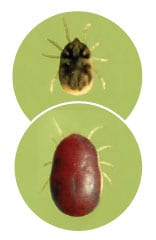
SOFT TICK Ornithodoros spp.
WHERE FOUND Throughout the western half of the United States, including Texas.
TRANSMITS Borrelia hermsii, B. turicatae (tick-borne relapsing fever [TBRF]).
COMMENTS Humans typically come into contact with soft ticks in rustic cabins. The ticks emerge at night and feed briefly while people are sleeping. Most people are unaware that they have been bitten. In Texas, TBRF may be associated with cave exposure.
O. hermsi tick, before and after feeding. Photo taken by Gary Hettrick RML, NIAID.
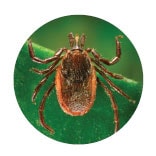
WESTERN BLACKLEGGED TICK Ixodes pacificus
WHERE FOUND In the Pacific Coast states.
TRANSMITS Anaplasma phagocytophilum (anaplasmosis), B. burgdorferi (Lyme disease), and very likely B. miyamotoi (Borrelia miyamotoi disease, a form of relapsing fever).
COMMENTS Larvae and nymphs often feed on lizards, birds, and rodents, and adults more commonly feed on deer. Although all life stages bite humans, nymphs and adult females are more often reported on humans.
Source: https://www.cdc.gov/ticks/tickbornediseases/tickID.html

0 Response to "Found Tick on Dog What to Do"
Post a Comment